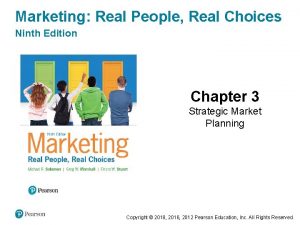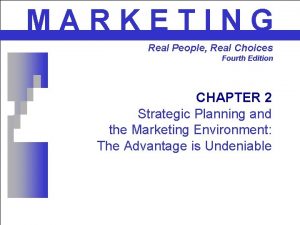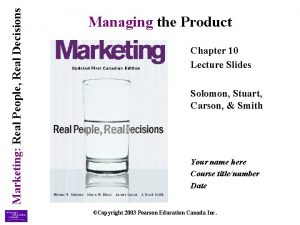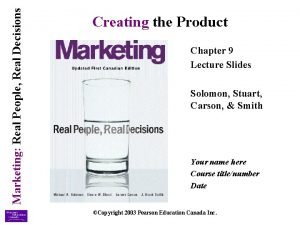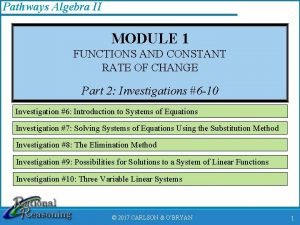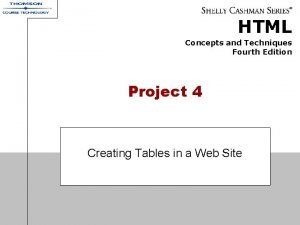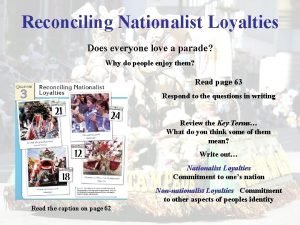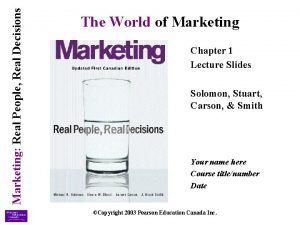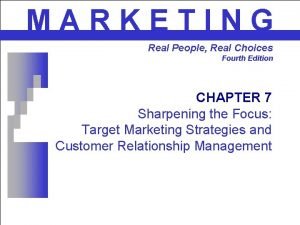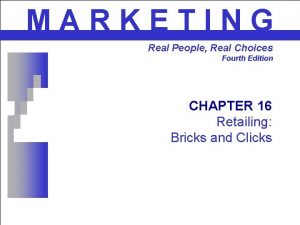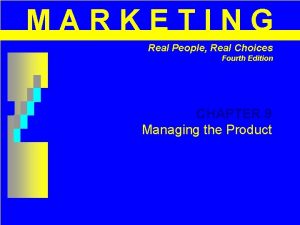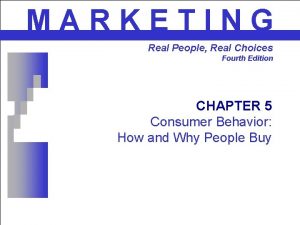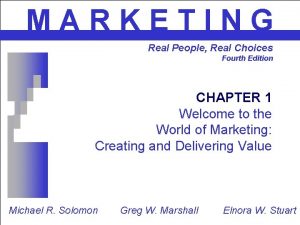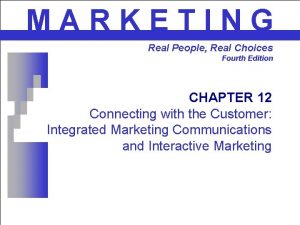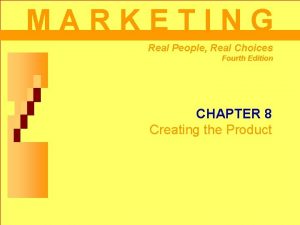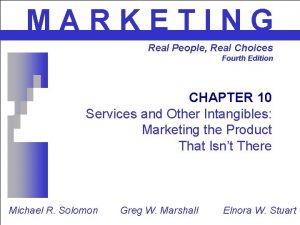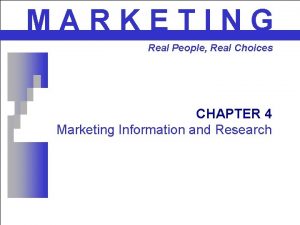MARKETING Real People Real Choices Fourth Edition CHAPTER





















- Slides: 21

MARKETING Real People, Real Choices Fourth Edition CHAPTER 16 Retailing: Bricks and Clicks

Chapter Objectives • Define retailing and understand how retailing evolves • Describe how retailers are classified • Describe the more common forms of nonstore retailing • Describe the B 2 C e-commerce, its benefits, limitations, and future promise • Understand the importance of store image to a retail positioning strategy and explain how a retailer can create an image in the marketplace 16 -2

Retailing • Final stop on the distribution path • The process by which products are sold to consumers for personal use • Retailers add value with image, inventory, service quality, location, and pricing policies 16 -3

The Wheel of Retailing • New types of retailers find it easiest to enter the market by offering goods at lower prices than competitors; after they gain a foothold, they gradually trade up, improving facilities and increasing the quality and assortment of merchandise, and offering special amenities; upscaling increases costs causing prices to rise; higher prices open the door for a new entrant charging lower prices 16 -4

Retail Life Cycle • Retailers are also products because they provide benefits and must offer a competitive advantage to survive – Introduction: new retailer takes a unique approach to doing business – Growth: retailer catches on with shoppers, sales and profits rise, others start to copy it so retailer expands offerings – Maturity: many have copied it and an entire industry has formed, profits decline – Decline: retail format becomes obsolete 16 -5

What’s in Store for the Future • Demographics • Technology • Globalization 16 -6

Major Demographic Factors • Convenience for consumers • Catering to specific age segments • Recognizing ethnic diversity 16 -7

Classifying Retailers • All retailers are classified by the NAICS codes • Some lines still blurred – scrambled merchandising – strategy of carrying a combination of food and nonfood items 16 -8

Classifying Retailers by Service • Self-service retailers • Full-service retailers • Limited-service retailers 16 -9

Classifying by Merchandise Selection • Merchandise breadth is the number of different product lines available – Narrow versus broad assortments • Merchandise depth is the variety of choices available for each specific product – Shallow versus deep assortments 16 -10

Store Types • • • Convenience stores Supermarkets Specialty stores Department stores Hypermarket stores • Discount stores – General merchandise discount stores – Off-price retailers – Warehouse clubs – Factory outlet stores 16 -11

Nonstore Retailing • Any method a firm uses to complete an exchange that does not require a customer visit to a store – Direct selling – Automatic vending 16 -12

Direct Selling • Direct selling occurs when a salesperson presents a product to one individual or a small group, takes orders, and delivers the merchandise – Door-to-Door Sales – Parties and Networks • party plan systems • multilevel pyramid schemes 16 -13

Automatic Vending • Appealing for selling convenience goods because of small space required, and minimal personnel to maintain and operate – French fries – Software – Levi’s jeans 16 -14

E-Commerce and the Customer • Benefits – Shop 24/7 – Less travel – More choices – More information – Price competition – Fast delivery • Limitations – Lack of security – Fraud – Can’t touch items – Hard to distinguish color/ texture online – Expensive to return 16 -15

E-Commerce and the Marketer • Benefits • Limitations – The world is your – Lack of security marketplace – Must maintain site – Decreases costs – Price competition – Very specialized – Conflicts with businesses conventional possible retailers – Real-time pricing – Legal issues not resolved – Tracking of consumer behavior 16 -16

Developing a Store Positioning Strategy • Store image – how the target market perceives the store – its market position relative to the competition • Atmospherics – the use of color, lighting, scents, furnishings, sounds, and other design elements to create a desired setting 16 -17

Store Design: Setting the Stage • • • Store layout and traffic flow Fixture type and merchandise density The sound of music Color and lighting The Actors: Store Personnel Pricing policy 16 -18

Building the Theater: Store Location • Types of locations • Site selection – Location planners evaluate trade area and conduct site evaluation • traffic flow, number of parking spaces available, ease of delivery access, visibility from street, local zoning laws, population characteristics, community life cycle, mobility, degree of competition 16 -19

Site Selection • • • Reflect growth strategy Convenient to customers in trade area Population characteristics Degree of competition Target market location 16 -20

Issues for Discussion • Why do retailers usually enter with low-priced goods and then increase over time? Is this the right path for all retailers? • Is Wal-Mart’s power in the marketplace good for consumers? For retailing? Why do some communities prevent Wal-Mart from opening? • Do you feel that atmospherics affect your purchase behavior? • What effect will the growth of e-retailing have on traditional retailing? 16 -21
 Slidetodoc.com
Slidetodoc.com Marketing: real people, real choices
Marketing: real people, real choices Marketing real people real choices
Marketing real people real choices Marketing real people real decisions
Marketing real people real decisions Marketers classify innovations based on their
Marketers classify innovations based on their Project 2 fourth edition
Project 2 fourth edition Algebra 2 module 1 answer key
Algebra 2 module 1 answer key Ethics in information technology fourth edition
Ethics in information technology fourth edition Ethics in information technology fourth edition
Ethics in information technology fourth edition Vertical line code in html
Vertical line code in html Discrete mathematics with applications fourth edition
Discrete mathematics with applications fourth edition Expert systems: principles and programming, fourth edition
Expert systems: principles and programming, fourth edition Proactive
Proactive Habit 1: be proactive examples
Habit 1: be proactive examples Habit 1 be proactive examples
Habit 1 be proactive examples Proactive language vs reactive language
Proactive language vs reactive language Contending nationalist loyalties
Contending nationalist loyalties How do nationalist loyalties shape people's choices
How do nationalist loyalties shape people's choices Marketing real people
Marketing real people Using mis 10th edition
Using mis 10th edition Using mis (10th edition)
Using mis (10th edition) Lesson 2 making responsible decisions and setting goals
Lesson 2 making responsible decisions and setting goals

